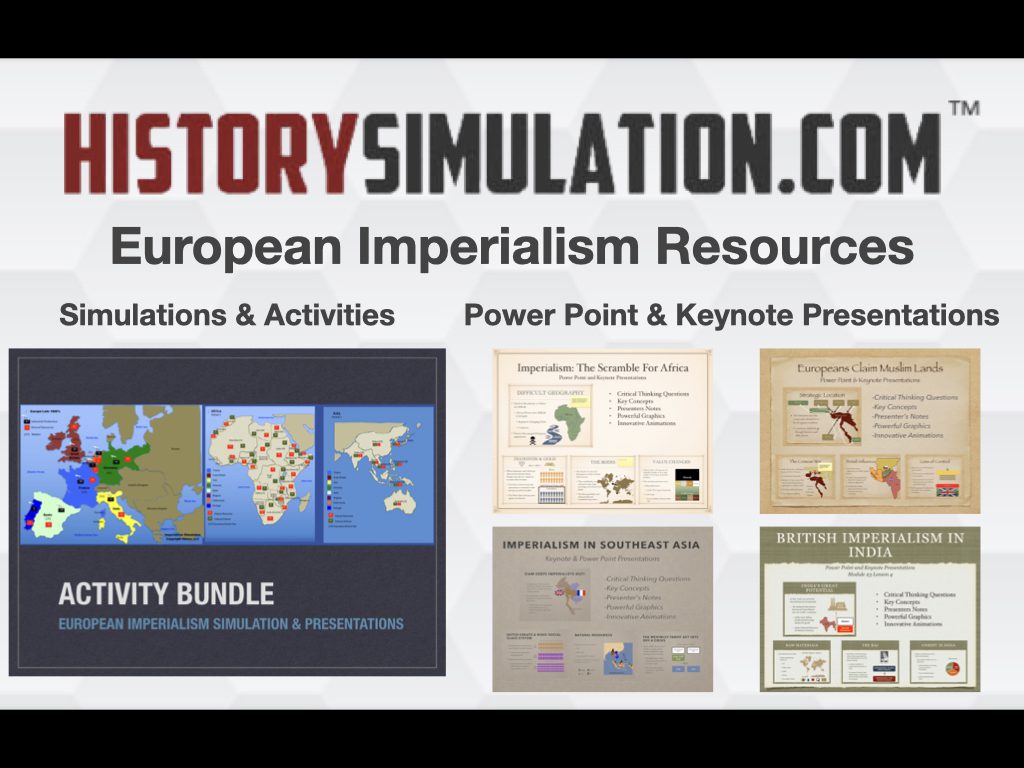IMPERIALISM FOR KIDS
RESOURCES TO TEACH KIDS ABOUT EUROPEAN IMPERIALISM
Study Guides
Below you will find Mr. Harms History Presentation Study Guides for European Imperialism For Kids in The Middle East, Africa, Asia and India.
Classroom Resources
Click the image or button on the right to go to see activities and presentations for the classroom.
Policy of extending a nation's power and influence through diplomacy or military force.
Imperialism Study Guides
Imperialism In Africa
The Scramble For Africa shows how European countries moved quickly to conquer regions of Africa for their resources, cheap labor and markets for finished goods. One of the first regions that sparked European interest was the Congo. King Leopold II of Belgium made treaties to acquire this land and exploited the people in it. Social Darwinism convinced Europeans of their superiority over African peoples. The Berlin Conference of 1884-1885 divided Africa for European countries. Africa was exploited for its cash crops and mineral resources. The Zulus fought the British from the 1700's to 1800's but eventually gave way to British control of South Africa.
Imperialism In The Middle East
Europeans Claim Muslim Lands describes how European countries militarily or political dominated lands in Southwest Asia to control their resources and enrich their rulers will little regard for the people. This lesson starts with the decline of the Ottoman Empire. Selim III tries to modernize the Empire and is overthrown. Russia moves to gain access to the Black Sea in the Crimean War. Russia and Great Britain struggled to carve out pieces of the fading Ottoman Empire in the Great Game. Britain and Russia compete for influence over Persia.
Imperialism In Southeast Asia
Southeast Asia was rich in natural resources: oil, minerals and agricultural products. European countries like the Netherlands seek resources and many Dutch moved to the region later called the Dutch East Indies. The British descend on Burma and Malaysia which was rich in Rubber resources. The French take control of parts of Vietnam, Cambodia and Laos to control French Indochina. These countries exploited cash crops which created great wealth but did nothing to improve the lives of native peoples. In the Spanish American War, the United States took Puerto Rico, Guam and the Philippines as U.S. Territories. Hawaii becomes part of the United States as it was annexed in 1898.
British Imperialism In India
British Imperialism In India describes how Great Britain militarily and politically dominated India and controlled their resources and people. The British East India Company set up trading posts in Bombay, Madras and Calcutta. The Mughal Empire initially kept European traders under control. Eventually, Great Britain controlled all of the natural resources of India and used them for their factories. The British set up systems to control the Indian economy for Great Britain's benefit. Two major world events shifted supply chains to India: The Crimean War and The American Civil War. Colonialism has positive, but mostly negative effects for the people of India. The Sepoy Mutiny shows how the British Government had no regard for the Indian beliefs. The Raj was the time period where India came under the direct rule of the British crown.
Imperialism Links:
a. Maps, Graphics and pictures about Imperialism in the Middle East, India, Africa and Asia.
a. Hollywood movies and documentaries about imperialism.


